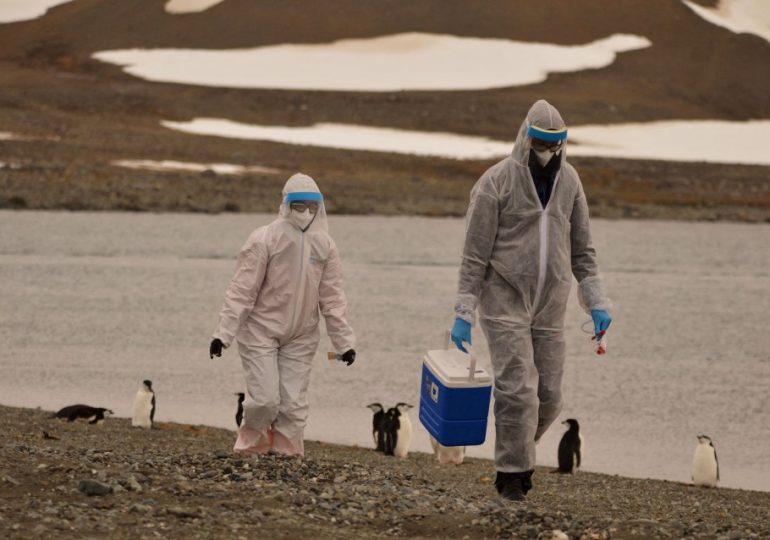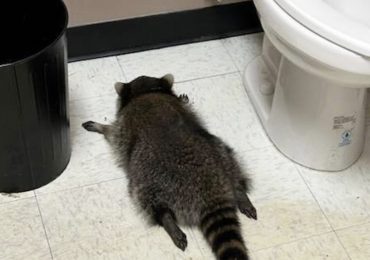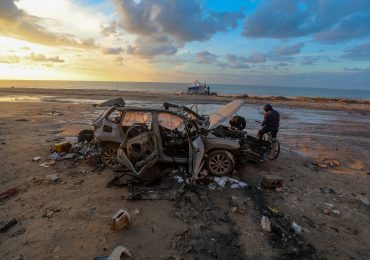THOUSANDS of penguins are thought to have been killed by a deadly outbreak of bird flu stoking fears of an “Antarctic Plague”.
The H5N1 strain could even be “dangerously close” to triggering another pandemic, experts have warned.
ReutersScientists in hazmat suits collect samples in Antarctica where they found thousands of dead penguins, thought to have been killed by the H5N1 bird flu virus[/caption]
ReutersResearchers investigate other dead birds on Beak Island, Antarctica[/caption]
GettyAdelie penguins leap off floating icebergs near Paulet Island, Antarctica[/caption]
Scientists have seen a H5N1 strain of the infection in cows, cats and even humans.
One expert warned at an urgent briefing that the flu could be “100 times worse than Covid”.
It comes after researchers found the hordes of dead Adelie penguins in Antarctica last month.
They believe the aquatic birds died from the deadly H5N1 bird flu, but field tests have yet to officially confirm if this is the case.
Samples from the sea of dead penguins have been shipped off for testing in the hope that researchers can provide more answers in the coming months.
But a research team did discover evidence of the deadly strain in Antarctica, as well as three nearby islands in seabirds that feed on penguins.
The emergency briefing came after a dairy farm worker in Texas tested positive for the virus.
Tests carried out on the worker showed their infection had already mutated.
The CDC said there was no sign yet of human-to-human transmission.
Bird flu experts, doctors and officials from government agencies flocked to the meeting.
It’s organiser, John Fulton, a pharmaceutical industry consultant for vaccines and founder of company BioNiagara, warned:
“This appears to be 100 times worse than Covid, or it could be if it mutates and maintains its high case fatality rate.
“Once it’s mutated to infect humans, we can only hope that the [fatality rate] drops.”
The White House is tracking the virus, which could mutate and become more transmissible amongst humans.
Some at the meeting urged caution against panic – saying it was too early to sound the alarm for another pandemic.
The bird flu strain has recently moved more aggressively throughout animal populations than ever before.
After arriving in South America two years ago it rapidly spread to Antarctica, where the first H5N1 case was officially confirmed in February.
Meagan Dewar, a biologist with Federation University who went out to investigate the penguin deaths, said they were found frozen solid.
The majestic birds were dead and covered in snow on Heroina Island.
Her team believes several thousand died over a period of several weeks, maybe months.
Around 280,000 Adelie penguins breed on the island each year before moving on.
Emperor penguins, who are at risk of extinction by 2100, could also face the terrifying bird flu.
Dr Kuchipudi, a bird flu researcher in the US, warned: “This virus [has been] on the top of the pandemic list for many, many years and probably decades.
“And now we are getting dangerously close to this virus potentially causing a pandemic.
“H5N1 viruses have already demonstrated several important features of a potential pandemic virus.”
He added: “So, therefore, in my view, I think this is a virus that has the greatest pandemic threat [that is] playing out in plain sight and is globally present.”
“It is really high time that we are prepared.”
What is H5N1 bird flu?
BIRD flu is an infectious type of influenza that spreads amongst birds and can sometimes affect humans.
There are four strains, H5N1 was first documented in 1997.
Several people have been infected around the globe leading to a number of deaths, although this is uncommon.
The virus can be spread from infected birds – whether dead or alive – to humans.
This happens by touching the birds, their droppings or bedding or cooking with infected poultry.
Markets where live birds are sold can also be a source of the flu.
There is currently no vaccine.
Symptoms include:
a very high temperature
feeling hot or shivery
muscle aches
headache
shortness of breath or coughing
Source: NHS
ReutersResearchers working on Devil Island in Antarctica a few weeks ago[/caption]
Leave a comment








